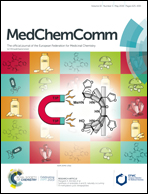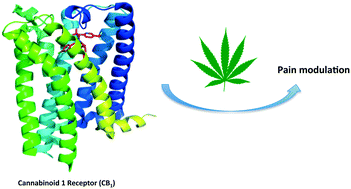 “Cannabinoid receptors type 1 (CB1) and type 2 (CB2) are promising targets for a number of diseases, including obesity, neuropathic pain, and multiple sclerosis, among others.
“Cannabinoid receptors type 1 (CB1) and type 2 (CB2) are promising targets for a number of diseases, including obesity, neuropathic pain, and multiple sclerosis, among others.
Upon ligand-mediated activation of these receptors, multiple receptor conformations could be stabilized, resulting in a complex pattern of possible intracellular effects. Although numerous compounds have been developed and widely used to target cannabinoid receptors, their mode of action and signaling properties are often only poorly characterized.
From a drug development point of view, unraveling the underlying complex signaling mechanism could offer the possibility to generate medicines with the desired therapeutic profile.
Recently, an increased interest has emerged for the development of agonists that are signaling pathway-selective and thereby do not evoke on-target adverse effects. This phenomenon, in which specific pathways are preferred upon receptor activation by certain ligands, is also known as ‘biased signaling’.
For a particular group of cannabinoid receptor ligands (i.e. CB1/CB2 agonists), namely the synthetic cannabinoid receptor agonists (SCRAs), the research on biased signaling is still in its infancy and interesting outcomes are only recently being revealed.
Therefore, this review aims at providing insights into the recent knowledge about biased agonism mediated by SCRAs so far. In addition, as these outcomes are obtained using a distinct panel of functional assays, the accompanying difficulties and challenges when comparing functional outcomes are critically discussed. Finally, some guidance on the conceptualization of ideal in vitro assays for the detection of SCRA-mediated biased agonism, which is also relevant for compounds belonging to other chemical classes, is provided.”
https://www.ncbi.nlm.nih.gov/pubmed/31472128
https://www.sciencedirect.com/science/article/abs/pii/S0006295219303132?via%3Dihub
 “It is thought that endogenous cannabinoids have a role in the analgesia induced by specific forms of stress.
“It is thought that endogenous cannabinoids have a role in the analgesia induced by specific forms of stress.


 “Globally, chronic pain is a major therapeutic challenge and affects more than 15% of the population. As patients with painful terminal diseases may face unbearable pain, there is a need for more potent analgesics.
“Globally, chronic pain is a major therapeutic challenge and affects more than 15% of the population. As patients with painful terminal diseases may face unbearable pain, there is a need for more potent analgesics.


 “There is a growing surge of investigative research involving the beneficial use of cannabinoids as novel interventional alternatives for multiple sclerosis (MS) and associated neuropathic pain (NPP).
“There is a growing surge of investigative research involving the beneficial use of cannabinoids as novel interventional alternatives for multiple sclerosis (MS) and associated neuropathic pain (NPP).


 “Increases in cancer diagnosis have tremendous negative impacts on patients and their families, and major societal and economic costs. The beneficial effect of chemotherapeutic agents on tumor suppression comes with major unwanted side effects such as weight and hair loss, nausea and vomiting, and neuropathic pain. Chemotherapy-induced peripheral neuropathy (CIPN), which can include both painful and non-painful symptoms, can persist 6 months or longer after the patient’s last chemotherapeutic treatment. These peripheral sensory and motor deficits are poorly treated by our current analgesics with limited effectiveness. Therefore, the development of novel treatment strategies is an important preclinical research focus and an urgent need for patients. Approaches to prevent CIPN have yielded disappointing results since these compounds may interfere with the anti-tumor properties of chemotherapeutic agents. Nevertheless, the first (serotonin noradrenaline reuptake inhibitors [SNRIs], anticonvulsants, tricyclic antidepressants) and second (5% lidocaine patches, 8% capsaicin patches and weak opioids such as tramadol) lines of treatment for CIPN have shown some efficacy. The clinical challenge of CIPN management in cancer patients and the need to target novel therapies with long-term efficacy in alleviating CIPN are an ongoing focus of research. The endogenous
“Increases in cancer diagnosis have tremendous negative impacts on patients and their families, and major societal and economic costs. The beneficial effect of chemotherapeutic agents on tumor suppression comes with major unwanted side effects such as weight and hair loss, nausea and vomiting, and neuropathic pain. Chemotherapy-induced peripheral neuropathy (CIPN), which can include both painful and non-painful symptoms, can persist 6 months or longer after the patient’s last chemotherapeutic treatment. These peripheral sensory and motor deficits are poorly treated by our current analgesics with limited effectiveness. Therefore, the development of novel treatment strategies is an important preclinical research focus and an urgent need for patients. Approaches to prevent CIPN have yielded disappointing results since these compounds may interfere with the anti-tumor properties of chemotherapeutic agents. Nevertheless, the first (serotonin noradrenaline reuptake inhibitors [SNRIs], anticonvulsants, tricyclic antidepressants) and second (5% lidocaine patches, 8% capsaicin patches and weak opioids such as tramadol) lines of treatment for CIPN have shown some efficacy. The clinical challenge of CIPN management in cancer patients and the need to target novel therapies with long-term efficacy in alleviating CIPN are an ongoing focus of research. The endogenous